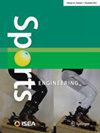用于人体运动分类的时间加权运动历史图像
IF 1.4
Q3 SPORT SCIENCES
引用次数: 0
摘要
基于视觉的人类活动分类在运动环境中具有显著的应用潜力(例如,提高成绩的运动分析,运动员的主动感知等)。近年来,基于学习的人类活动分类得到了广泛的研究。然而,在需要更详细和针对特定球员的分类的体育场景中,这是一项相当具有挑战性的任务;在许多情况下,只有有限数量的数据集可用,不像走路或爬楼梯等日常运动。因此,本文提出了一种时间加权的运动历史图像,这是一种有效的图像序列表示,用于基于学习的人类活动分类。与传统的基于“新框架更重要”假设的MHI不同,我们的方法生成重要性感知表示,以便预测器可以“看到”有助于分析特定人类活动的框架。实验结果表明了该方法的优越性。本文章由计算机程序翻译,如有差异,请以英文原文为准。
Time-weighted motion history image for human activity classification in sports
Abstract Vision-based human activity classification has remarkable potential for various applications in the sports context (e.g., motion analysis for performance enhancement, active sensing for athletes, etc.). Recently, learning-based human activity classifications have been widely researched. However, in sports scenes in which more detailed and player-specific classifications are required, this is a quite challenging task; in many cases, only a limited number of datasets are available, unlike daily movements such as walking or climbing stairs. Therefore, this paper proposes a time-weighted motion history image, an effective image sequence representation for learning-based human activity classification. Unlike conventional MHI based on the assumption that “the newer frame is more important,” our method generates importance-aware representation so that the predictor can “see” the frames that contribute to analyzing the specific human activity. Experimental results have shown the superiority of our method.
求助全文
通过发布文献求助,成功后即可免费获取论文全文。
去求助
来源期刊

Sports Engineering
SPORT SCIENCES-
CiteScore
2.40
自引率
17.60%
发文量
23
期刊介绍:
Sports Engineering is an international journal publishing original papers on the application of engineering and science to sport. The journal intends to fill the niche area which lies between classical engineering and sports science and aims to bridge the gap between the analysis of the equipment and of the athlete. Areas of interest include the mechanics and dynamics of sport, the analysis of movement, instrumentation, equipment design, surface interaction, materials and modelling. These topics may be applied to technology in almost any sport. The journal will be of particular interest to Engineering, Physics, Mathematics and Sports Science Departments and will act as a forum where research, industry and the sports sector can exchange knowledge and innovative ideas.
 求助内容:
求助内容: 应助结果提醒方式:
应助结果提醒方式:


